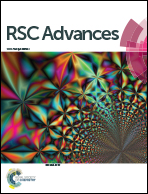A supramolecular approach to metal ion sensing: cystine-based designer systems for Cu2+, Hg2+, Cd2+ and Pb2+ sensing†
Abstract
We have synthesized two cystine containing molecules S1 (pyrene-labelled) and S2 (tryptophan-labelled) and demonstrated that the former can detect Cu2+, and the latter can detect Hg2+ in acetonitrile. The 1 : 1 mixture of S1 and S2 forms a heterodimeric system S1 : S2, which was confirmed by mass spectrometric, UV-Visible and fluorescence spectroscopic studies. Additional proof for the formation of S1 : S2 came from 1H NMR, CD, ITC, ultramicroscopic and computational studies. The supramolecularly assembled S1 : S2 detects Pb2+ in nanomolar levels. A control compound S3 containing tryptophan and pyrene units showed totally different binding properties compared to S1, S2 and S1 : S2. DFT studies on S1 : S2 establish that S1 in S1 : S2 adopts an extended conformation, thereby keeping the pyrene units proximal to the indole moiety of S2 for energy transfer. The binding of Pb2+ with S1 : S2 brings the two pyrene units into proximity resulting in a folded structure and the formation of the excimer. These results clearly demonstrate a hitherto unknown and unexpected organization of two fluorescent molecules leading to a new supramolecular system capable of Pb2+ detection.


 Please wait while we load your content...
Please wait while we load your content...